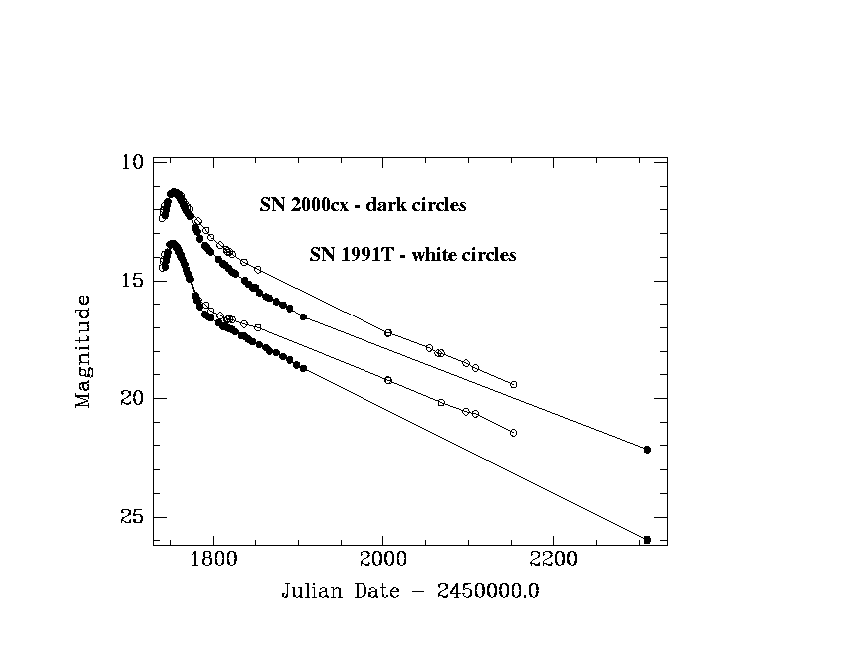SN 2000cx

sn2000cx was observed on Feb 3 ,2002.
There will be another observation :
VisitNum: 97
Visit Status: Scheduling
Targets: SN2000CX
Configs: WFPC2
Plan Windows:
Jun 21, 2002 - Jul 3, 2002 (2002.172 - 2002.184)
Jul 4, 2002 - Jul 12, 2002 (2002.185 - 2002.193)
We'll try to switch to ACS.
To: pchallis@cfa.harvard.edu, pgarnavi@miranda.phys.nd.edu,
weidong@astron.berkeley.edu
Subject: Re: sn2000cx
The magnitudes Pete measured agree with the linear extrapolation
of KAIT light curves VERY well, especially in the B band. There
may be a small (smoothly) slow down in the V band.
SN 2000cx declines much faster than 1991T. See a figure of the
comparison including the HST points at:
http://astron.berkeley.edu/~weidong/late.ps
Weidong
To: pchallis@cfa.harvard.edu, weidong@astron.berkeley.edu,
weidong@astron.berkeley.edu
Subject: Re: sn2000cx
99by was normal blue at 50 to 100 days and then stayed
blue, bluer than the normal Ia. I think the colors
late say more about the conditions in the nebula (temperature
and abundance). The spectrum is dominated by FeII and FeIII
lines and it is their distribution that determines the color.
How fast did 2000cx decline recently? That is another clue.
99by declined slowly which may indicate a large mass ejected
even though the SN as a fast decliner. The decline rate
for 2000cx might give an idea about the mass ejected.
Peter
To: pchallis@cfa.harvard.edu, pgarnavi@miranda.phys.nd.edu,
weidong@astron.berkeley.edu
Subject: sn2000cx
HST observed sn2000cx on Feb 3, 2002
I get
F439W 25.97 +/- 0.13
F555W 24.16 +/- 0.04
(not to blue is it.... unlike sn99by... which was very blue,
does this trend of delta m15 vs color @ late time mean anything ? )
I'm using the dolphin zeropoints from
http://www.noao.edu/staff/dolphin/wfpc2_calib/
I counted up the counts with 2 pixel aperture.
then calculate CTE,
apply geometric correction,
apply aperture correction 2 pixel - 5 pixel,
apply zeropoint,
apply CTE
mag=-2.5*alog10(final_counts/exptime)-xcte-ycte+zero
error is calculated by (IRAF method !!! scary!!)
flux = sum - area * sky
mag = zmag - 2.5 * log10 (flux) + 2.5 * log10 (itime)
merr = 1.0857 * error / flux
error = sqrt (flux / epadu + area * stdev**2 +
area**2 * stdev**2 / nsky)
zmag = 25.0, itime = 1
Gain = 7, read noise = 0.72
